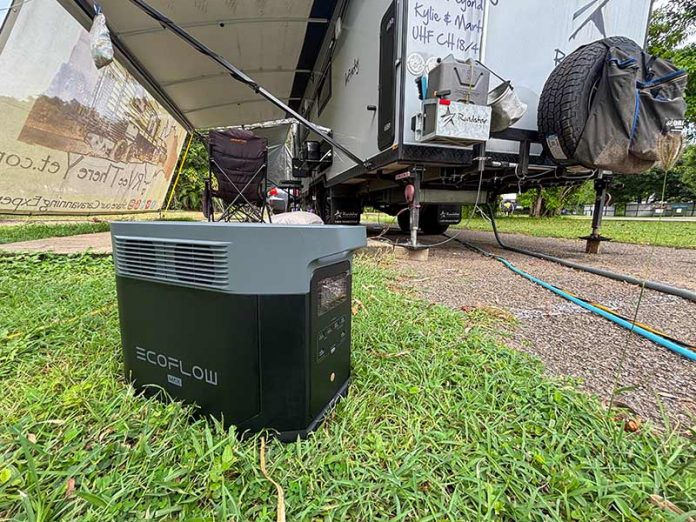We recently looked at how a portable lithium power station such as the EcoFlow Delta 2 could be a viable alternative to a petrol-powered generator. In that article, I suggested the 1024Wh battery in the Delta 2 would be suitable for most caravanners and campers.
But what if you needed more power? What if you needed to use appliances with seriously high power demands? Well, EcoFlow has just released the Delta 2 Max and we were fortunate to be one of the first in Australia to get our hands on this unit to test its remarkable capabilities.
ECOFLOW DELTA 2 VS DELTA 2 MAX
At this point, it’s probably a good idea to have a look at the Delta 2 from the feature in issue 83 of GoRV, and compare it to its bigger sibling.
Visually, they both look very similar with nearly identical layouts. The main controls and display are on the front, while the 240V outlets, 12V outlets and charging plugs are at the rear. This arrangement may seem a little unorthodox at first but, in use, it works well especially if you want to operate the unit in the back of your tow vehicle.
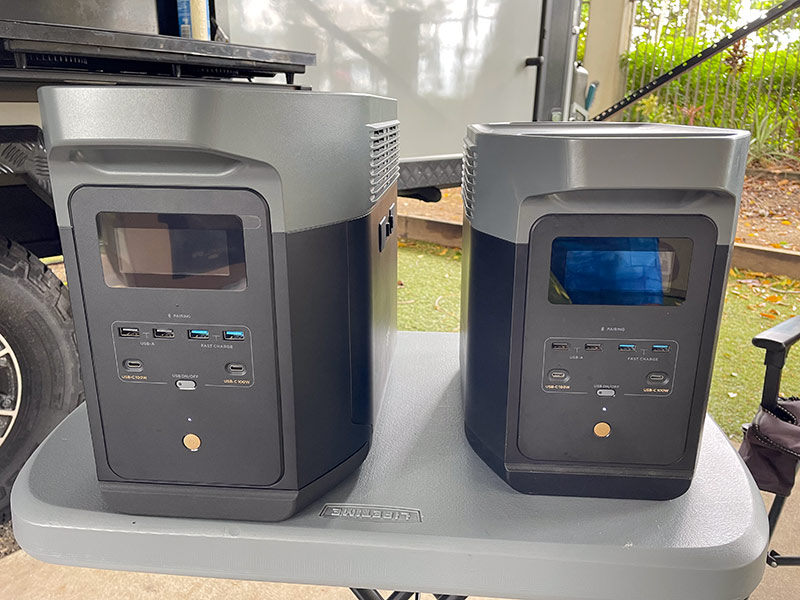
Apart from the obvious size difference, there is a considerable weight difference to consider. With twice the battery capacity of the Delta 2, the Delta 2 Max weighs almost twice as much; 12kg compared to 23kg. That’s to be expected given the Delta 2 Max’s lithium iron phosphate (LiFePO) battery has twice the capacity of the Delta 2 at a whopping 2048Wh.
That weight may seem quite heavy but consider a 2000W petrol generator will weigh about the same (at least) and, as far as other 2kW lithium power stations go, the EcoFlow Delta 2 Max weighs about 30 per cent less than its competition.
Where the Delta 2 Max stands out is in its electrical capabilities. The inverter has an impressive standard output of 2400W but this can be bumped up to an astonishing 3100W using the Delta 2 Max’s ‘X-Boost’ technology. If that’s not enough, it will deliver a surge output of up to 4800W! Try doing that with your 2000W petrol generator.
This incredible capacity means the Delta 2 Max can run some seriously high-wattage appliances such as caravan air-conditioners and air fryers. Even the mighty ThermoMix is within the capabilities of the Delta 2 Max.
RECHARGING CAPABILITIES
Having that output capacity would be useless if you couldn’t recharge the unit quickly enough to be used again and, here too, the Delta 2 Max has some pretty impressive abilities.
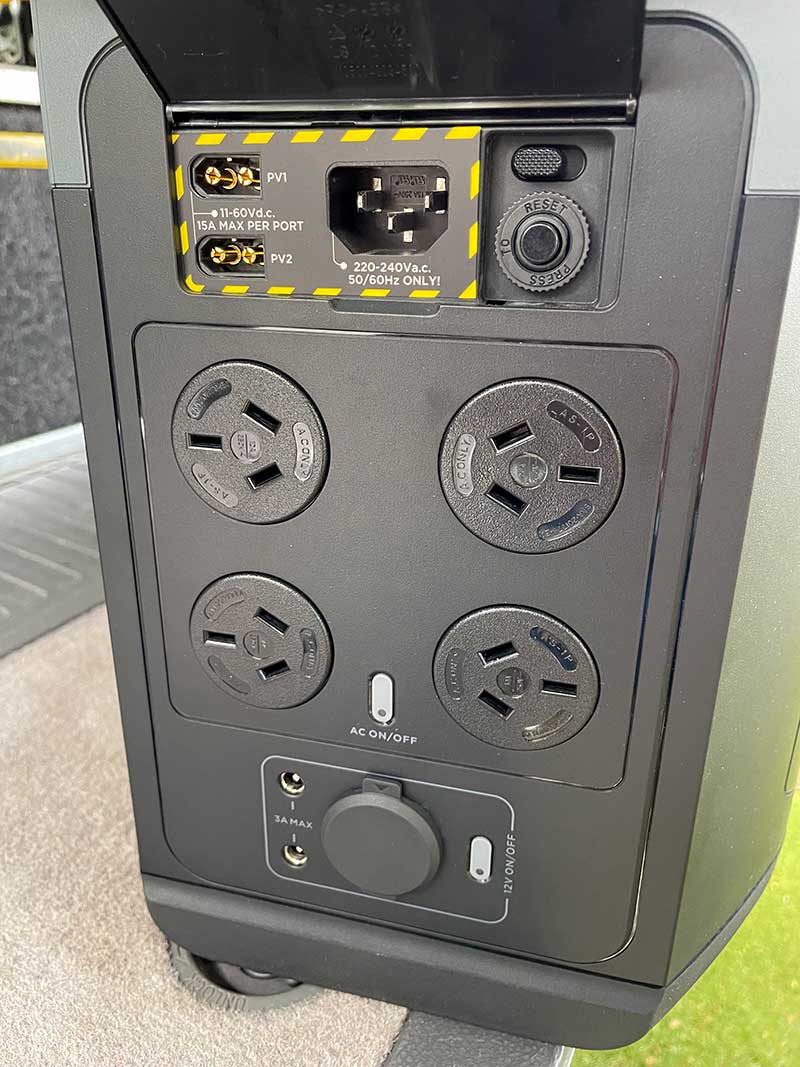
Solar charging is catered for by two MPPT controllers, each capable of accepting up to 500W of solar panels each. That’s 1000W of solar input – enough to recharge a depleted Delta 2 Max to 100 per cent in just 2.3 hours.
Now, I realise very few caravanners will carry that much solar capacity but also consider you could connect two of EcoFlow’s 400W bi-facial portable solar panels and recharge in as little as 2.8 hours.
If you have access to 240V mains, the Delta 2 Max can be charged at up to 2300W from a standard 10A outlet in a little over an hour.
The Delta 2 Max also shares the same variable charge input function as the Delta 2. Here, you can set that actual AC charge wattage via the EcoFlow app from anywhere between 200W and 2400W. This is extremely useful if you have an inverter in your car or caravan.
Using excess solar input from your rooftop panels, you can set the charge rate to a level that will not impact your batteries’ state of charge.
Of course, you can also recharge the Delta 2 Max from your tow vehicle’s 12V system. At present, you can plug directly into a cigarette lighter outlet and charge at a rather slow 100W. You can also connect the Delta 2 Max directly to your car’s alternator output and charge at around 200W, or wire up a Victron DC-DC converter and charge at a respectable 400W.
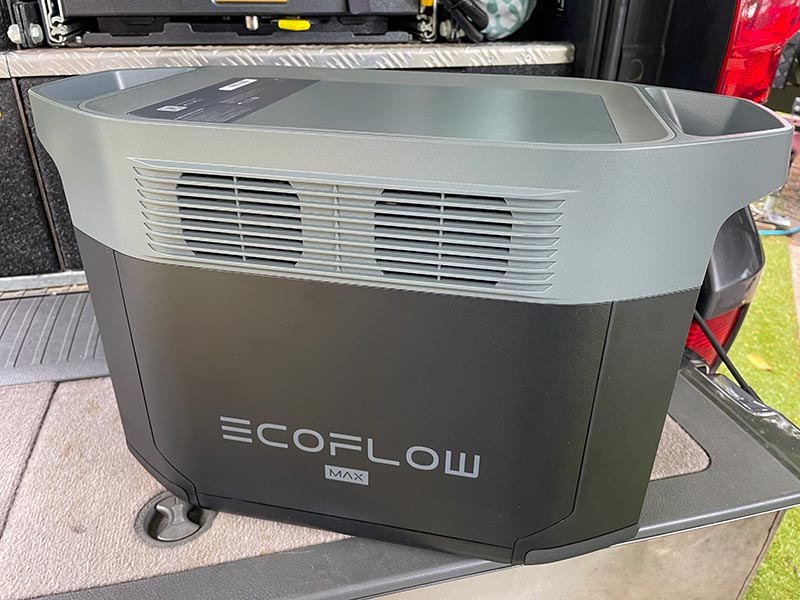
EcoFlow recognises these rates may not be fast enough for owners of the Delta 2 Max and, in response, have announced that it is about to release its own DC charger that will be able to deliver up to 800W of charge. This unique system can also be connected to a caravan or motorhome’s house battery as an option. We can’t wait to get our hands on one!
THE ECOFLOW APP
One of the best things about owning an EcoFlow product is the smart device app. It is brilliant. You can control and monitor all aspects of the Delta 2 Max’s setup and operation. You can control the power to the 240V, 12V and USB outlets separately, set the AC charge rate, check the battery level and monitor solar input. It is intuitive and very easy to use.
One feature that stands out is that the app supports full remote control via the internet. If you have a wi-fi router with either a mobile broadband or satellite internet connection, you can connect the EcoFlow Delta 2 Max to your wi-fi and now, when you leave your van, the app will function remotely using your phone’s internet connection.
I’ve tested this using our Starlink in the van and have been able to control and monitor the Delta 2 Max from anywhere very successfully.
THE DELTA 2 IN USE
The key features of the Delta 2 Max are its big battery and its big inverter, so rather than muck around with a bunch of small loads, I thought I’d try to push this beast to its limits.
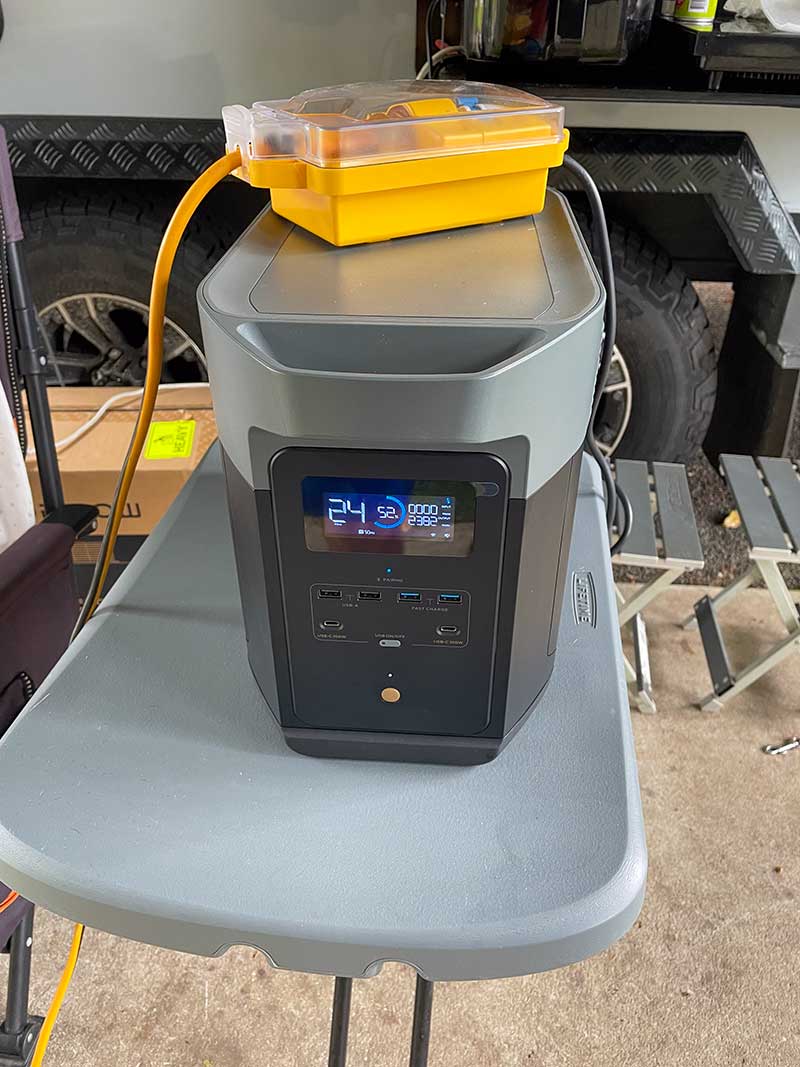
The first test was to plug our caravan into the Delta 2 Max in order to try running our Truma Aventa air-conditioner. It did that without so much as a hum from the internal fans.
Now, the Truma has a current draw of 4.2A when cooling, which equates to 1008W. While that’s a decent load, it’s well within the capacity of the Delta 2 Max’s inverter and it will run for at least two hours on a fully charged battery.
While that may not seem all that impressive, it doesn’t tell the full story. The Truma, like all air-conditioners, has a big electric pump to spin up when it’s powered on and this initial spike can hit 28A or over 6700W. This is why so many petrol generators fail to power air-conditioners. The Delta 2 Max soaked this up without a fuss.
Regardless, if anyone was going to do this on a regular basis, I would recommend starting up the fan first and then engaging the air-conditioner, just to lessen the initial load.
Once the air-conditioner was running, I used the microwave to heat a cup of water. This too runs at around 1000W and the Delta 2 Max handled this as well.
To test out the cut-off safety feature, I then tried to use our electric kettle, which draws a very high 2500W and, at this point, the EcoFlow shut down the inverter to prevent any damage to the system or the internal battery. I was impressed.
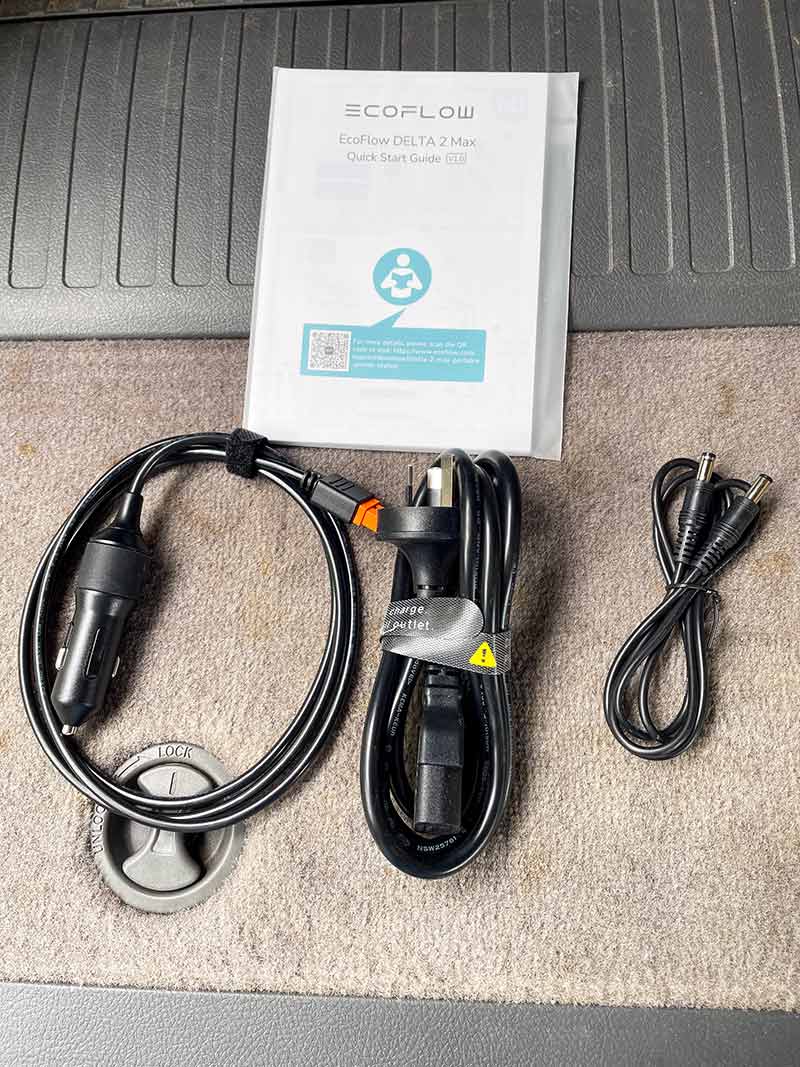
The next test was to try to cook a meal with not one but two high-watt appliances. I connected our 4L air fryer and our induction cooktop, and used both to cook a full meal in 20 minutes. The display showed the output hit 2380W, just shy of the inverter’s nominal maximum output and, again, it handled this without a worry. At this point, I was convinced of the capabilities of the EcoFlow Delta 2 Max.
In the weeks since this initial test, I’ve been using the Delta 2 Max as the main power source for cooking and, depending on usage times for each appliance, it will easily go three to four days between recharge cycles. If your off-grid camping needs to include the use of high-wattage appliances, then Delta 2 Max is the perfect solution.
ANY DRAWBACKS?
There really isn’t much to complain about the EcoFlow Delta 2 Max. It does everything EcoFlow claims it will do, which is about as much as you can expect. It is a heavy unit but you would know that when you buy one and, with the two sturdy grab handles, it’s not too awkward to carry around the campsite.
If I had one complaint, it would be that the Australian 240V outlets on the Delta 2 Max are 10A only. While there are four outlets, which makes it easy to spread the load, it does mean that to plug your caravan into it, you will need a 10A to 15A safety converter.
I also did notice a slight discrepancy between the app settings for the 240V charger and the indicated rate on the display. Given our test unit was one of the first models in the country, I’d say it’s just a glitch that will be fixed with a firmware update.
CONCLUSION
I’ve made no secret of the fact that I’m a big fan of these portable lithium power stations. I do believe they can be a viable alternative to a petrol-powered generator in most circumstances and the EcoFlow Delta 2 Max is no exception. If you compare it to a similar-sized petrol generator, it will outperform it in almost every respect and ultimately prove more useful for the majority of travellers.
Priced at $2999 (RRP) the EcoFlow Delta 2 Max is not cheap but consider this: the Honda EU32i petrol generator with similar inverter specifications retails for $3799. That’s $800 more expensive than the EcoFlow.
When you take into consideration that you can use the Delta 2 Max anytime of the day or night without disturbing your neighbours, and that EcoFlow backs its gear with a five-year warranty, the Delta 2 Max is very good value for money.


